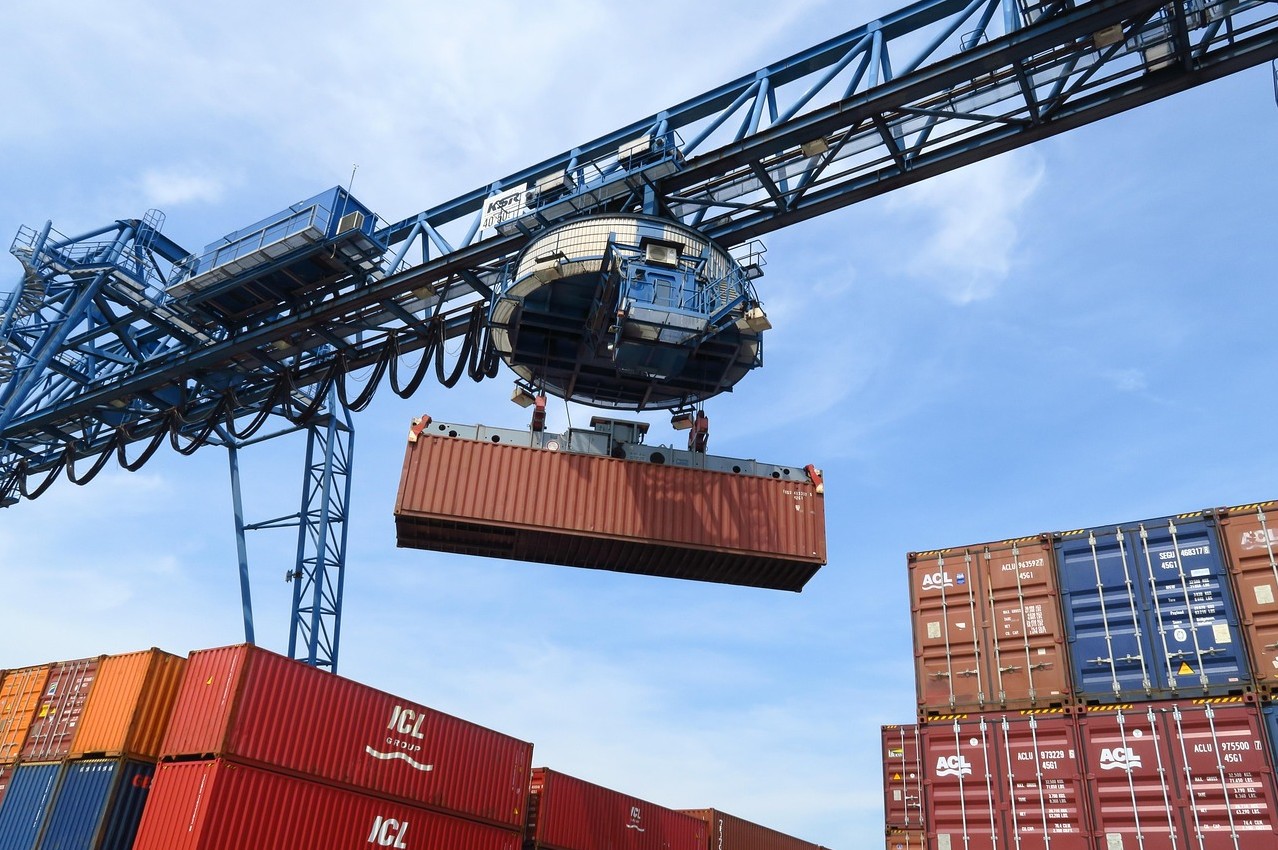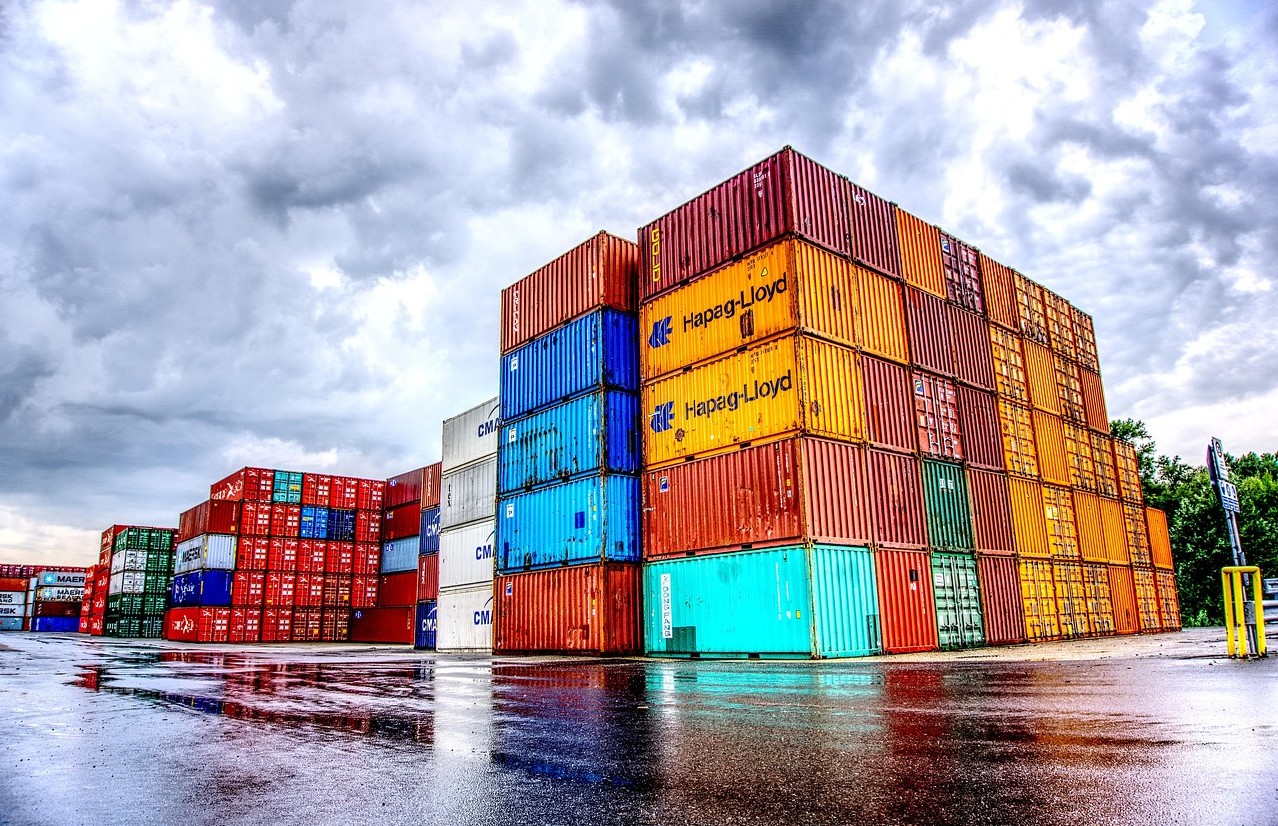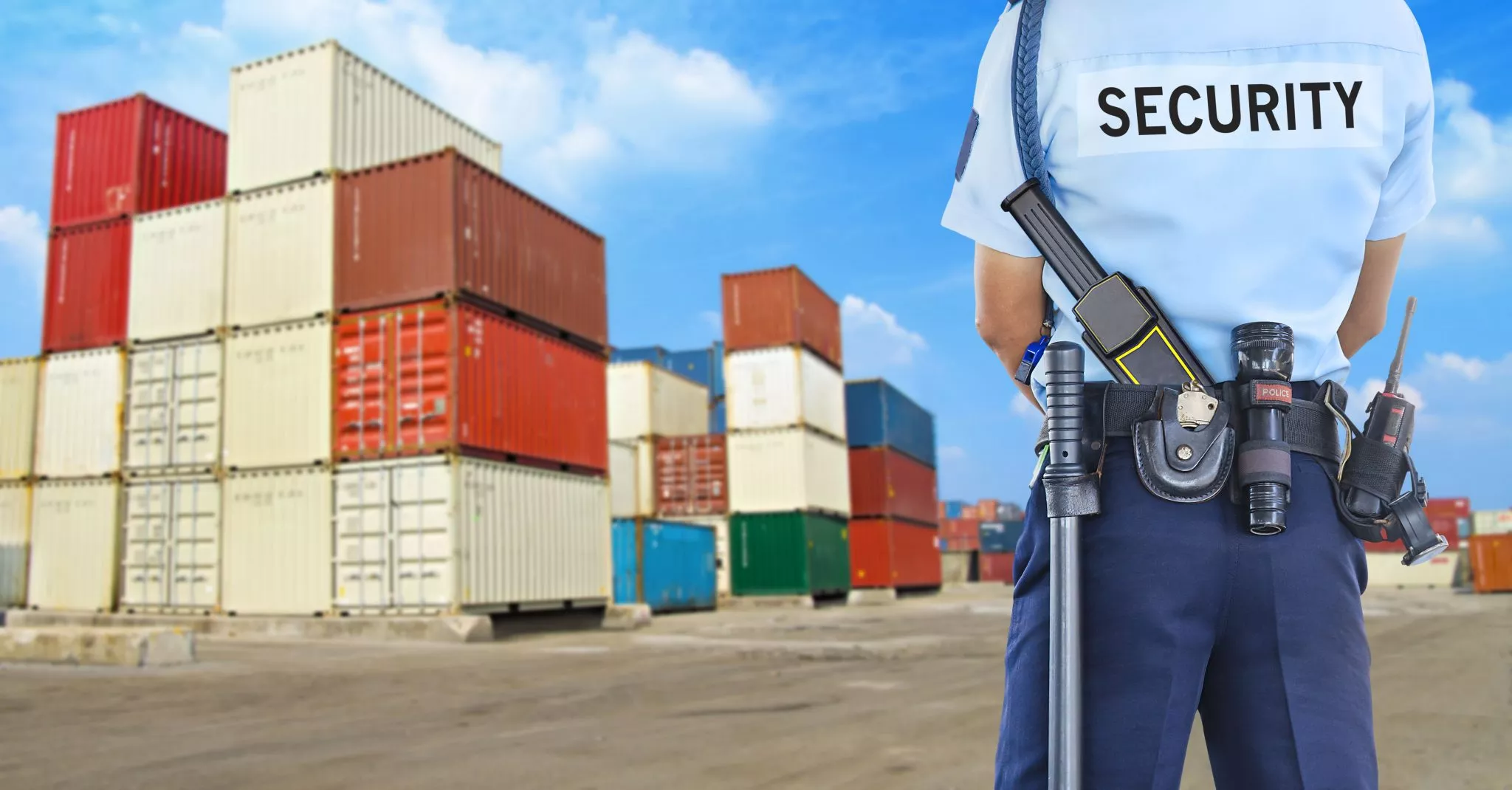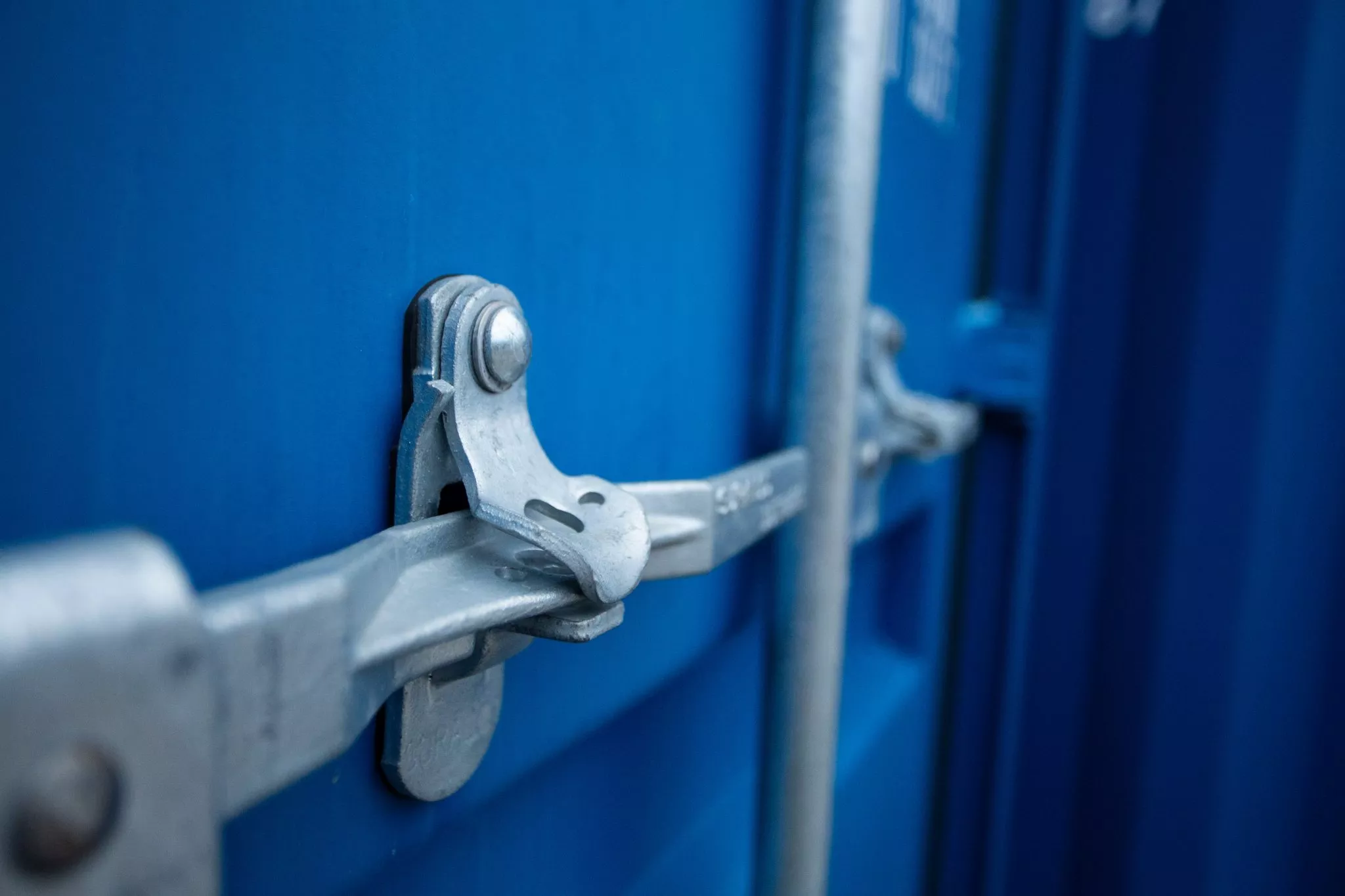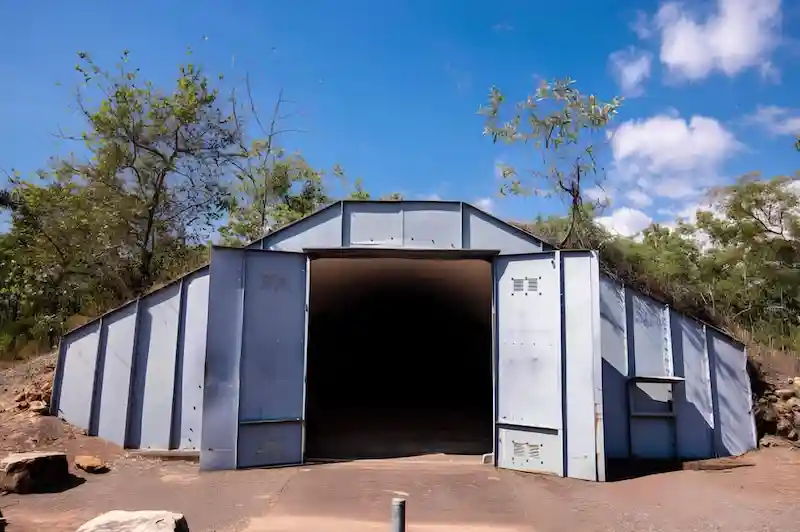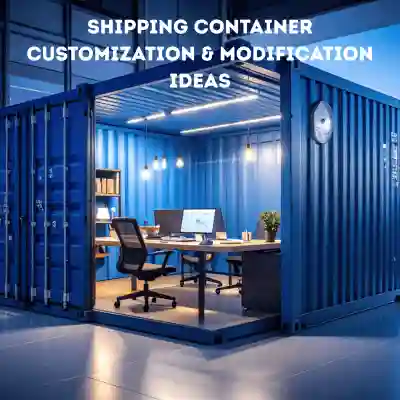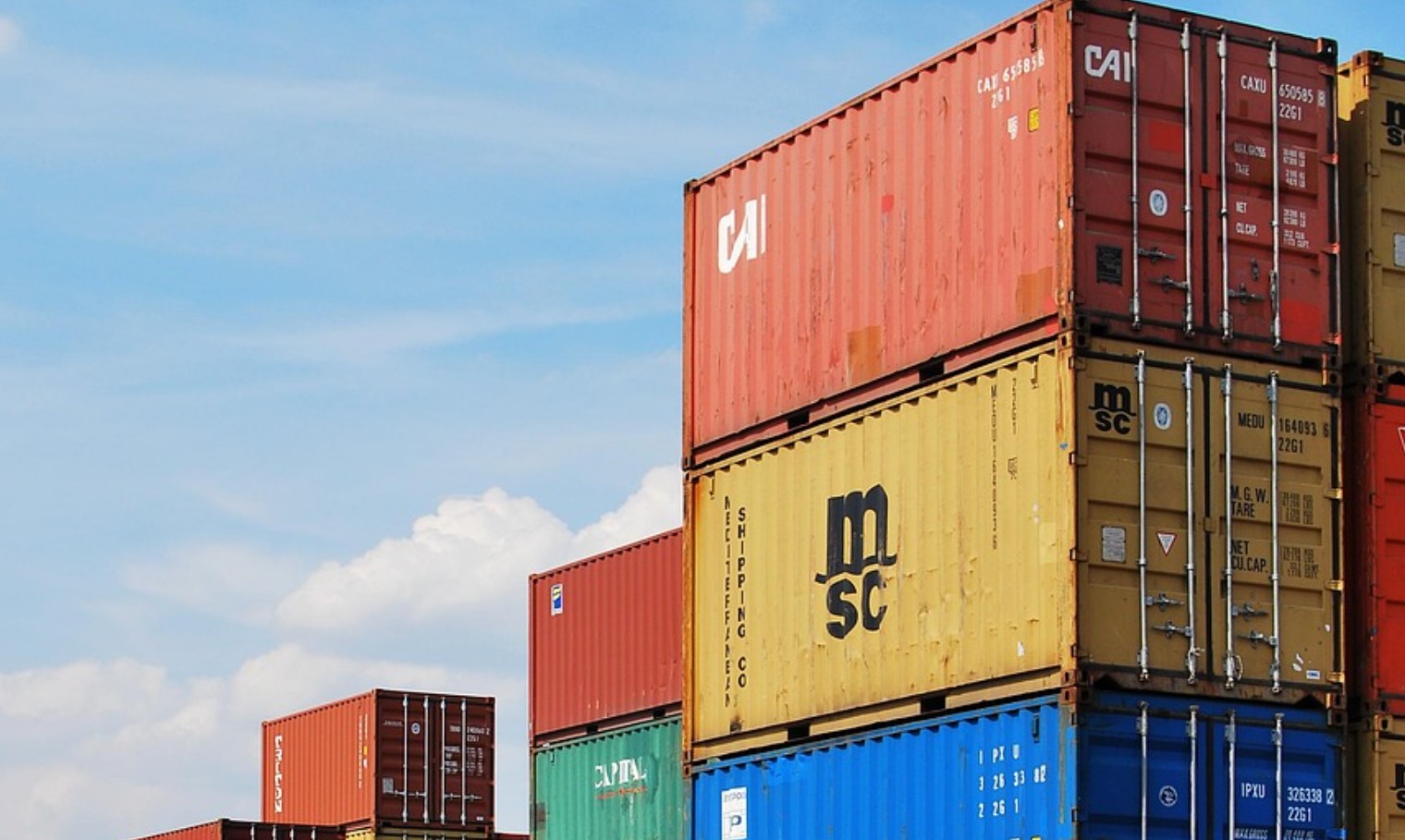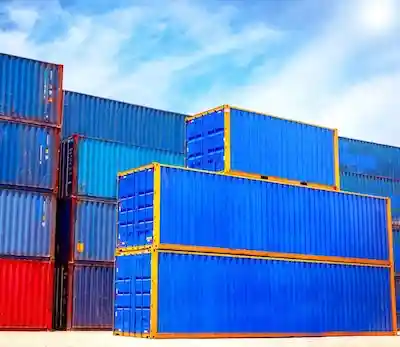Shipping Container Scams: How to Spot & Avoid

🎧 Listen while you read — this episode explains Shipping Container Scams: How to Spot & Avoid
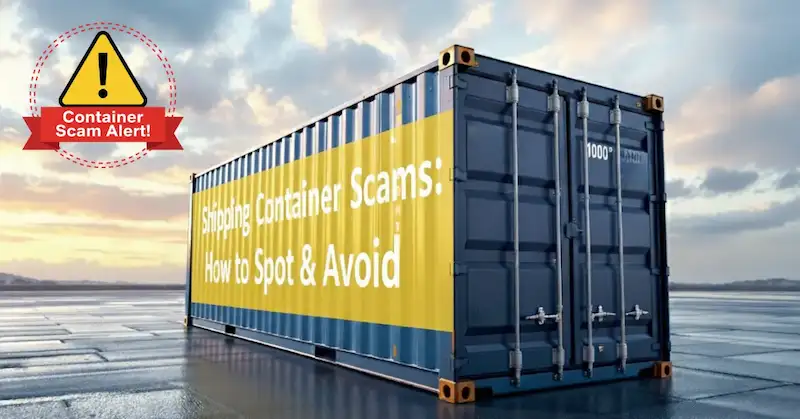
Read this blog to learn all about shipping container scams, how to spot and how to avoid them so you can buy shipping containers safely.
Shipping containers are in high demand across the globe, and this has led to a rise in container scams, where scammers take advantage of buyers searching for good deals online.
Many of these scams target genuine buyers searching online for affordable containers. You might come across convincing websites or social media listings that seem legitimate until you realize the seller never intended to deliver. These scams often look professional, using fake invoices, cloned logos, and even delivery promises to make the deal look real.
At Pelican Containers, we’ve seen firsthand how common shipping container scams have become. As a trusted container supplier in the U.S. with secure payments and vetted depots, we work hard to protect our customers and keep them informed.
That’s why we’ve created this detailed guide where you’ll learn all about these scams, which red flags to watch out for, how to avoid them, and what a legitimate container seller would look like. By the end, you’ll gain all the knowledge you need to make secure container deals online.
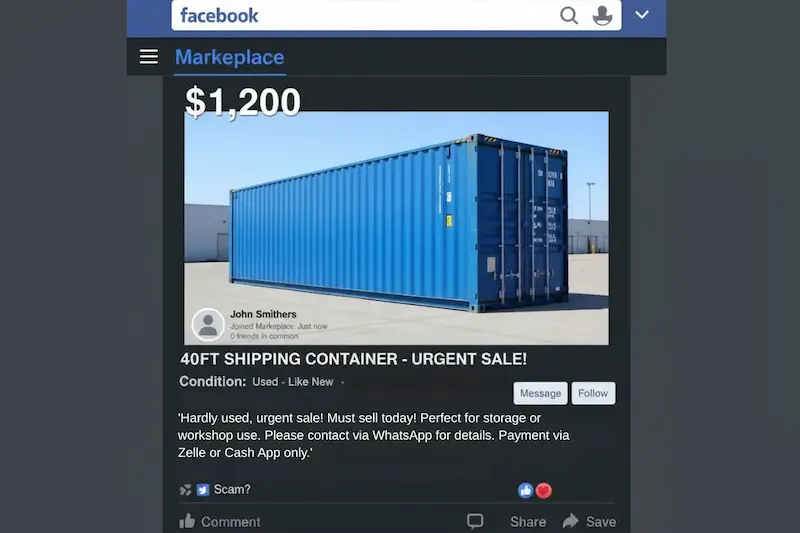
What is a shipping container scam?
A shipping container scam happens when fraudsters pose as legitimate sellers, take upfront payments from buyers, and disappear without delivering the shipping container. Their main goal is to collect money quickly through unsecured payment methods like Facebook Pay or direct transfers.
These scammers often post misleading ads on social media. Many of these cases fall under shipping container scams on Facebook, where fraudulent sellers use Marketplace listings to target unsuspecting buyers. They may also use Craigslist or create fake websites by using actual company names and photos.
Let’s understand these shipping container scams in more detail below.
What are the typical scam patterns used?
Scammers use several tactics to appear legitimate, like fake listings, cloned websites, or creating unrealistically cheap offers.
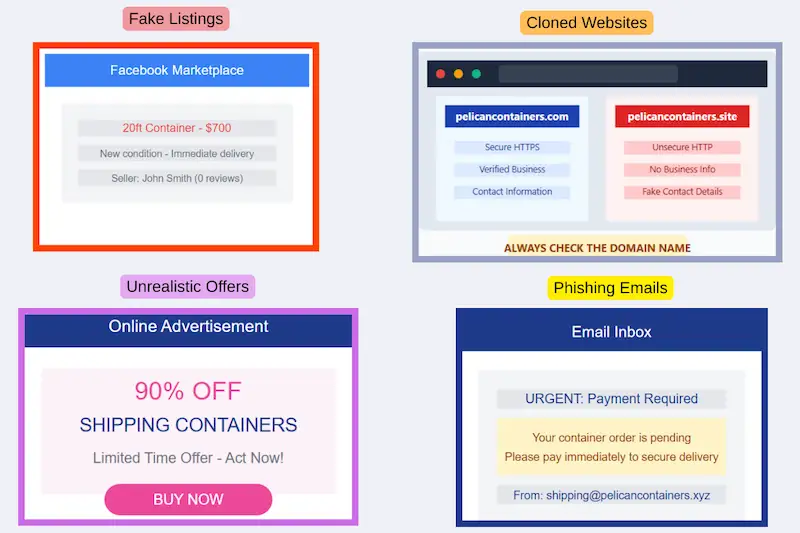
– Fake listings: Fraudsters create fake container listings, sometimes even on legitimate websites. They often use stolen images from real depots to build trust. Or, they may create listings with extremely low prices.
– Cloned websites: Entire websites copied from genuine suppliers, complete with fake reviews and contact forms. But these websites usually lack secure payment systems or proper contact verification.
– Identity theft and phishing emails: Scammers might also pretend to be associated with real companies and ask you to make payments directly to them. They may send phishing emails that include urgent payment requests to pressure you to make the payment quickly.
– Unrealistically cheap offers: If you see an offer for a new 20ft reefer shipping container for just $700, chances are it might be posted by a scammer. They create unrealistic, cheap offers to lure the buyers, and once you make the payment, these ads disappear.
It’s very easy to lose money through these scams. Let’s find out how.
How victims lose money through shipping container scams
Here are some of the most common ways you may lose money if you fall victim to shipping container scams.
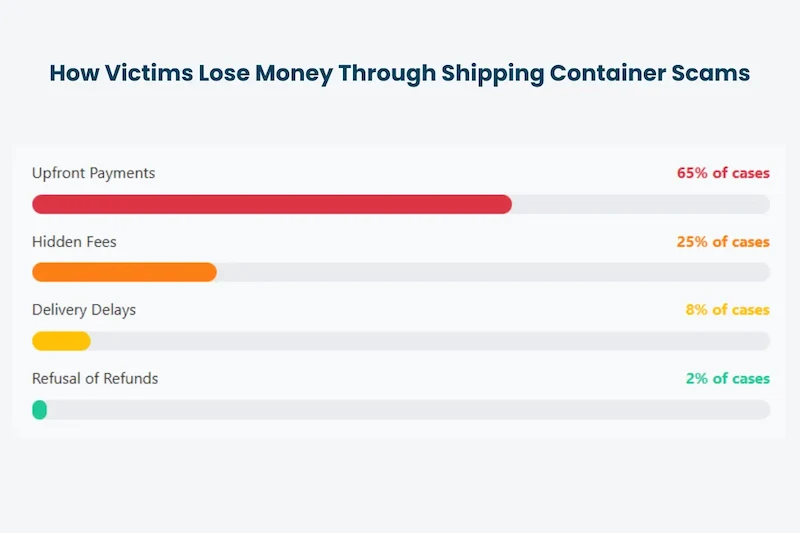
– Upfront payments: Most scammers will ask you to make upfront payments for the containers. Once you give them the money, they’ll disappear, leaving you with no proof of the purchase.
– Hidden fees: Another way shipping container scammers trick you into paying more is by adding several hidden fees to their offers, which you only realize once you’ve made the payment. For example, a container might be listed for $1,500, and once you make the payment, they’ll ask you for other fees to actually deliver the container.
– Delivery delays: This can look like experiencing repeated delivery delays until the seller stops responding. Scammers frame each delay as a logistics issue to buy time before disappearing. You lose the money you spent on buying the container, as well as your valuable time chasing the seller. It also affects your overall logistics planning.
– Refusal of refunds: Most scammers will avoid any communication once the payment is made. However, if you’re somehow in touch with them and request a refund, they deny it even if you have clear proof of payment.
The best way to protect yourself from shipping container scams is to avoid high-risk platforms for buying shipping containers. Read on to see which ones those are.
High-risk platforms for buying shipping containers
Scammers often use popular marketplaces and social media platforms to reach a wide audience.
Platforms like Facebook Marketplace and Craigslist are especially risky since anyone can post with minimal verification, making it easy for fake profiles to appear legitimate. Shipping container scams on Facebook Marketplace often start with fake listings that look trustworthy, using real photos and heavy discounts to lure buyers. Gumtree and eBay have also seen cases of fraudulent sellers offering deals that seem too good to be true, often disappearing once payment is made
These platforms are attractive to scammers because they allow quick setup and access to thousands of potential buyers with minimal verification.
That’s why you should always rely on trusted, legitimate websites like Pelican containers, which give you traceable business information and formal payment options.
Now that we’ve discussed all about shipping container scams, let’s talk about a few red flags that you can spot early to avoid falling victim.
How to recognize a container scam: Top 6 red flags to watch out for
Most scams show warning signs early on. If you know what to look for, you can avoid becoming a victim. Here are the top 6 red flags in container sales to watch out for.
Website and domain checks
Fake container websites often look professional but lack real business details. Before you buy:
- Check for HTTPS security in the web address.
- Use WHOIS lookup tools to see when the domain was created. Newer sites (less than a year old) are riskier.
- Verify that contact details match the company’s official information.
- Search for the company name and phone number to confirm authenticity.
- Look for spelling errors, copied text, or inconsistent pricing.
For example, the official website of Pelican containers is https://pelicancontainers.com/. However, recently we noticed a clone website with the URL pelicancontainers.site.
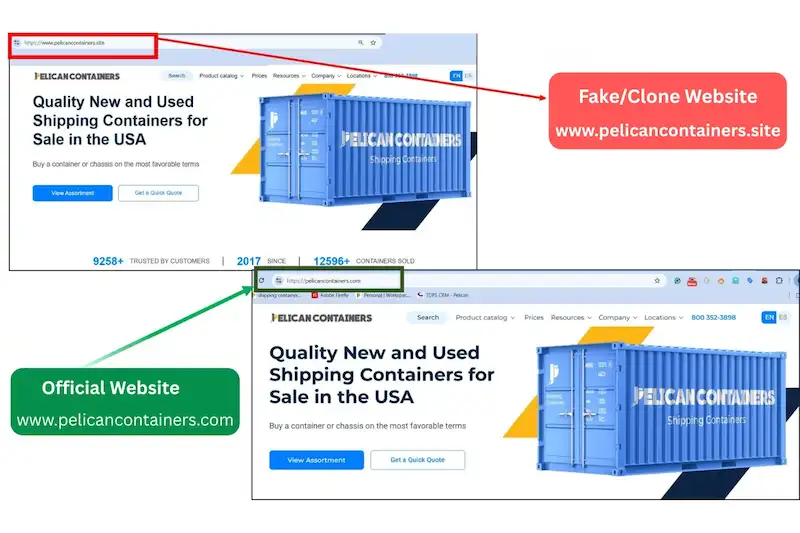
Notice how this website appears legitimate, but the only difference is the URL. Always check the website URL to make sure it’s secure and the right one.
Company identity & paperwork
Genuine suppliers are transparent about their company details. Before making any payment, always ask for a valid business registration number and tax details like VAT, EIN, or W-9 forms. You should also search for a physical business address that you can use on Google Maps.
Another great step to avoid shipping container scams is to have clear information about who issues the invoices at the seller’s company and who handles delivery. Verify the container seller and be in touch with the same person while making payments.
Quotes & invoices
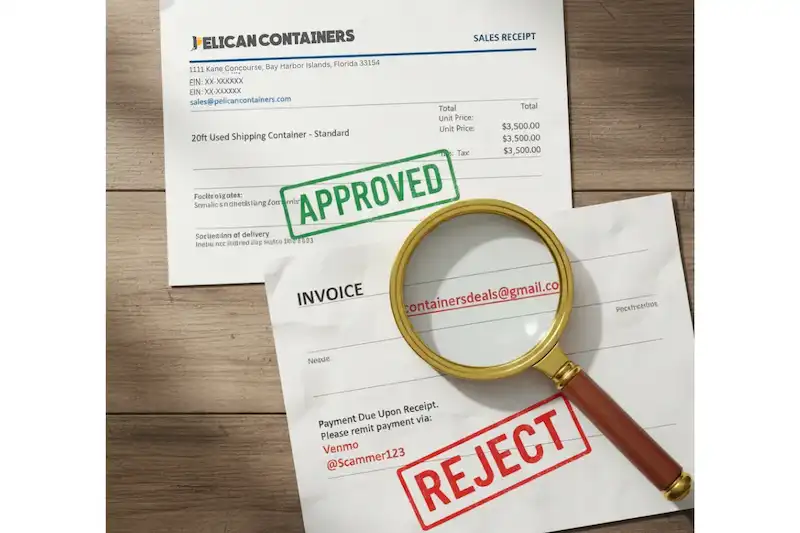
A legitimate payment invoice will include the company’s letterhead and the final container price. It will also have consistent contact information so you can contact the company easily.
On the other hand, fake invoices will use a generic template, will have a Gmail or personal email as contact information, and will have no official proof of the company’s address. It may also have inconsistent contact numbers or missing payment references.
Payment traps
When you buy a container online, always pay attention to how a seller asks for money. Scammers prefer quick, untraceable payment methods because they leave no way to recover your funds once the transaction is done.
You might be asked to send money through Facebook Pay, CashApp, Venmo, or Zelle. These apps are convenient for friends and family, but they offer no buyer protection in commercial deals.
If a seller insists on these options or pressures you to pay fast, it’s a clear warning sign.
To avoid container scams, use only verified and secure methods. Legitimate suppliers like Pelican Containers rely on secure bank transfers, escrow services, and trusted payment gateways that protect your money and help you make secure container payments.
Social proof signals
When you’re researching container sellers, take a moment to see how active they are online.
Real companies have a steady digital footprint that you can easily trace.
- Check their Google Reviews to see if they span across months or years, not just a sudden burst of activity.
- Browse through their photos and updates, where you should see genuine images from depots, deliveries, and happy customers, not the same few stock pictures used repeatedly.
- Look at how they respond to reviews or questions. Real businesses engage consistently with buyers.
Avoid sellers with all 5-star reviews posted in a short time or those that avoid interaction. You want to buy from a seller who has earned trust over time, not one who hides behind fake profiles or generic feedback.
Communication hygiene
Another red flag you should watch out for is how the sellers communicate with you. Professional sellers will always use branded company emails. If the seller communicates through their personal account on Gmail or Yahoo, pay attention.
For example, some of our clients reported receiving a phishing email from a newly created, unofficial address that demanded payment for a “pending” invoice. The message gave no order number, used a non-company domain, and pressured immediate transfer.
Those details are clear warning signs of shipping container fraud. A legitimate Pelican Containers representative will always email from @pelicancontainers.com, include your quote or order number, and provide clear payment instructions. That level of detail helps you confirm authenticity and protects your payment.
Verification checklist before you pay
Here’s a quick verification checklist you can keep handy when making your next container purchase. Share it with your team so they avoid shipping container scams too.
| 1. | Check if the company website is HTTPS-secured. |
| 2. | Confirm domain age and ownership. |
| 3. | Verify registration or tax numbers. |
| 4. | Ask for a physical address and confirm it on Google Maps. |
| 5. | Review invoices and payment instructions. |
| 6. | Compare pricing with other verified suppliers. |
| 7. | Request photos or serial numbers of available containers. |
| 8. | Look for customer reviews over time. |
| 9. | Speak directly with a sales representative. |
| 10. | Use only secure payment methods. |
Price comparison & market rates
Once you’ve gone through the verification checklist, the next step is to look closely at container pricing.
This is where many buyers get caught off guard because scam offers often look like bargains at first glance. Take your time to compare multiple quotes before making any decision. If an offer is more than 10% below the average market price, it’s usually a red flag. You can also look for consistency in pricing across different suppliers because major fluctuations often signal risk.
But even if you find a good deal and the listing seems legitimate, always ask for proof and paperwork to back up your purchase.
Request proof & paperwork
Ask the seller to share container serial numbers so you can verify authenticity, along with inspection reports or photos from the depot. Review a formal invoice and payment document that includes the company’s name, address, and tax details.
These steps protect you from last-minute surprises or hidden conditions. If a seller hesitates to provide this information or sends unclear paperwork, it’s safer to walk away. Proper proof and paperwork ensure your order is real, traceable, and backed by an accountable seller.
Real-world scam examples
Many of our customers have shared stories that show just how convincing fraudsters can be and how easy it is to overlook small details when you’re rushing to close a deal. Here are some real-world container scam examples to watch out for.
Fake Facebook seller: A buyer saw a listing on Facebook Marketplace offering containers 40% cheaper than competitors. The seller also requested full payment up front. After the transfer, all communication stopped, and the Facebook profile was deleted within days.
The red flag in this deal: Unrealistic discount and no verified business address.
Impersonated company: Scammers often create cloned websites of real suppliers, copying their logos and photos. For example, the official website of Pelican Containers is https://pelicancontainers.com/. However, recently we noticed a clone website with the URL pelicancontainers.site, which was designed to look identical to ours and trick buyers into making payments to fake accounts. The red flag to watch in this case is the mismatched email domains or a recently created website.
Additional fees scam: A seller promised fast delivery, but later demanded additional “customs clearance” and “insurance” fees. So the buyer ended up paying in full for the container, as well as all the additional fees. But the container never arrived, and soon all communication with the seller was also lost.
In this case, the clear sign of a scam was the seller’s request for extra charges after payment confirmation.
After learning all about how scams work and what warning signs to watch for, it’s just as important to understand what a legitimate buying experience should look like. That’s where we come in.
Buy shipping containers safely with Pelican containers
When you choose to buy shipping containers through Pelican containers, you’re choosing security, transparency, and trust at every step of the process. All our depots, partners, and payment systems are vetted to prevent fraud, and every order is handled by real representatives who guide you through the process.
Here’s how we offer a safe way to buy shipping containers:
- Verified Depots: Each of our containers is inspected and stored at authorized facilities across major U.S. states, ensuring the condition you’re promised is the one you receive.
- Transparent Pricing: All costs on our website are displayed upfront, with no surprise charges. Simply request a container quote and know exactly what you’re paying for. Browse through our product catalog to find the right fit for your needs.
- Active Customer support: Our dedicated team is available throughout the buying process to guide you, answer questions, and resolve issues quickly. You can contact us any time for updates, container delivery guidelines, or clarification on payment details.
And finally, we also offer safe payment options and allow you to inspect the container before you even make the purchase. Read on to know more.
Secure Payments & Buyer Protection
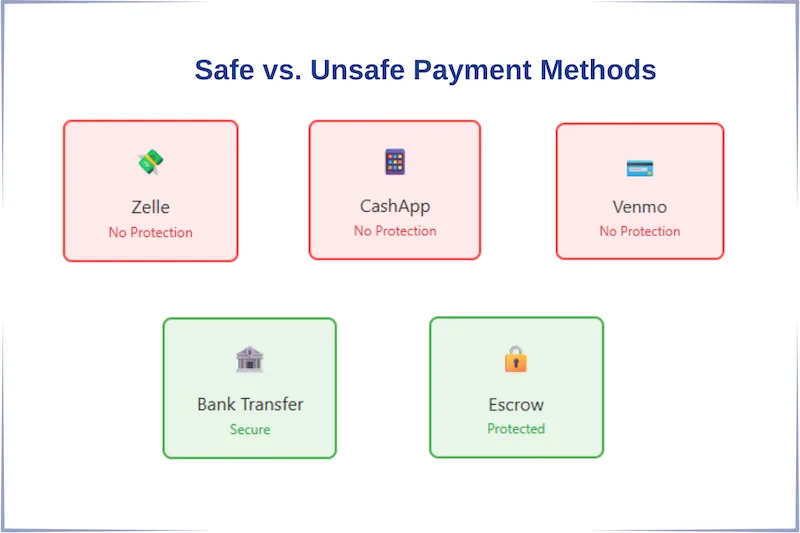
Every order placed through Pelican Containers comes with complete buyer protection designed to keep your purchase safe from start to finish. When you place an order, you receive instant payment confirmation, tracking details for your shipment, and direct access to our customer support team.
Our team stays in touch throughout the process to keep you updated on delivery timelines and address any questions you might have.
We never ask for personal transfers or social media payments because those methods can’t guarantee your safety. Instead, every transaction goes through our secure checkout, which uses verified banking channels to ensure your information and funds are protected.
This way, you can buy confidently knowing your order is legitimate, traceable, and backed by real people ready to help.
View before you buy
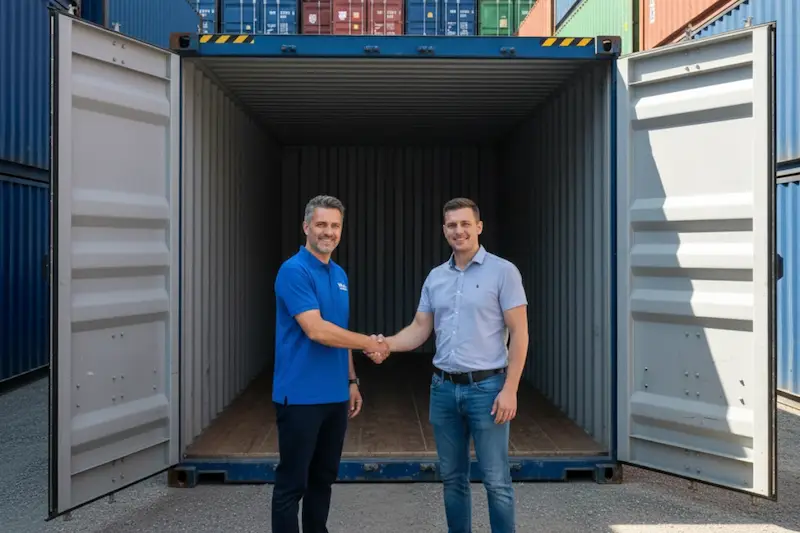
At Pelican Containers, we understand how important it is for you to feel confident about what you’re buying, so we offer viewings at our depots in major U.S. cities such as Miami in Florida.
During these visits, you can walk around the depot, inspect the condition of the container yourself, verify the serial number, and discuss any final details with our team before making payment. This in-person option adds an extra layer of transparency and trust to your buying experience.
But if you’re still unsure about whether you should even purchase a container, renting might be the right option for you. Here’s why.
Rent or buy a container- which is safer?
If you’re unsure about long-term needs, renting can be a safer choice because it allows you to test how a container fits your business before committing to a purchase. Renting gives you time to evaluate the condition, capacity, and delivery process while keeping your initial investment low. It’s a flexible option if you’re expanding operations or trying out new routes and don’t want to tie up capital right away.
However, when you’re ready to buy, Pelican Containers ensures the same level of safety, documentation, and transparency for purchasing. You can rely on our team to guide you through the process, provide verified paperwork, and make sure you get the right container for your long-term needs.
Final checklist & next steps
Now that you know all about shipping container scams, how to avoid them, and red flags to watch out for, here’s a handy 10-point list to summarize all that we’ve discussed in this blog.
- Never pay through unverified methods.
- Always check domain and email authenticity.
- Compare prices with multiple suppliers.
- Verify registration and address details.
- Ask for written invoices.
- Check long-term reviews.
- Avoid overly positive or new feedback.
- Speak to a real representative.
- Inspect containers before payment if possible.
- Only deal with verified sellers like Pelican Containers.
By choosing Pelican containers, you can trust that you’re making safe payments and buying containers from a legitimate seller.
Want to avoid shipping container scams and get straight to buying containers from a trustworthy seller? Get a verified container quote from Pelican Containers today.
Vatsala Singh is a B2B content strategist and writer specializing in the shipping, logistics, and container industry. She has written extensively about container types, container modifications, procurement challenges, and the market shifts that influence container demand.
With a Master’s degree in English Literature and strong research skills, she brings depth, clarity, and accuracy to every article. Through her content, she combines industry knowledge with practical insight, helping readers understand what’s happening in global trade and how it affects container buyers, freight forwarders, and equipment managers.
When she’s not writing, Vatsala is usually reading fiction, exploring new ideas, or learning about how different industries work.
She believes that good content should simplify complexity, support smarter decisions, and make the container world easier to navigate, one article at a time.
Vatsala Singh is a B2B content strategist and writer specializing in the shipping, logistics, and container industry. She has written extensively about container types, container modifications, procurement challenges, and the market shifts that influence container demand.
With a Master’s degree in English Literature and strong research skills, she brings depth, clarity, and accuracy to every article. Through her content, she combines industry knowledge with practical insight, helping readers understand what’s happening in global trade and how it affects container buyers, freight forwarders, and equipment managers.
When she’s not writing, Vatsala is usually reading fiction, exploring new ideas, or learning about how different industries work.
She believes that good content should simplify complexity, support smarter decisions, and make the container world easier to navigate, one article at a time.
